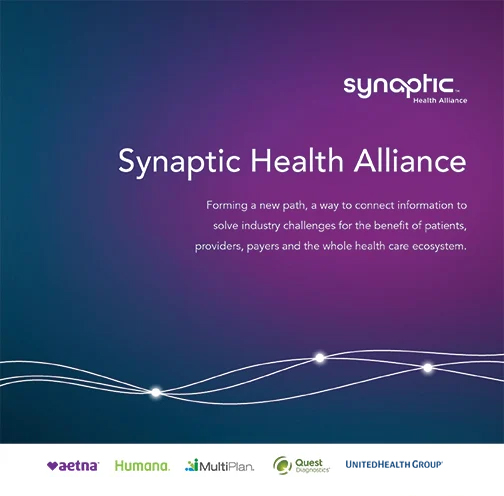
Using An Allocation Model to Help Maintain Accurate Health Care Provider Directories
The Allocation Model developed by Synaptic Health Alliance for its Provider Data Exchange seeks to address a $2.1 billion industry problem.
The lack of accurate health care provider data often impacts patients’ ability to find and obtain appropriate health care services in a timely manner. Industry-wide, $2.1 billion is spent every year maintaining and updating care provider demographic data such as name, address, specialty and phone number. Much of that effort is redundant across health plans that are required to maintain accurate care provider directories. Outreach to the same care provider by multiple health plans to confirm this information results in undue administrative burden and costs for both health plans and care providers. By combining and consolidating care provider directory maintenance efforts through what Synaptic Health Alliance is calling The Allocation Model, the industry can save time and money, improve quality and consistency of data and enhance patient access to health care.
Blockchain technology is at the core of Synaptic Health Alliance’s efforts to tackle the high cost and inefficiencies of maintaining accurate health care provider directories. Blockchain provides a secure and tamper-evident way for multiple health plans to share provider demographic information safely in a way that benefits both the sharer and the consumer of the data.
Through pilot tests, Synaptic Health Alliance found that sharing care provider data updates through a blockchain can improve directory quality, driving higher regulatory compliance, lower risk for fines, fewer pended claims and reduced operational costs. More importantly, it can improve the patient experience of navigating the health care system and reduce calls to care providers who are busier than ever amid the COVID-19 pandemic.
Allocation Model – A Key Element of the Provider Data Exchange
The Synaptic Health Alliance created the Allocation Model to help facilitate the division of labor amongst members in verifying individual care provider data and reduce validation fatigue. This approach is central to the accurate and efficient crowdsourcing of care provider data corrections through blockchain.
The premise of the Allocation Model is that health care providers are contacted frequently by various health care plans and health care network organizations to verify the accuracy of the care provider demographic information, such as: Are their doctors still seeing new patients? What is the most current address where they are providing care services? Is their phone number current and working? Importantly, the average health care provider in the U.S. does business with over 20 health care plans at any given time, and fielding these attestation outreaches via phone, email and online portals puts a high administrative burden on the care provider offices.
Using the Allocation Model, Synaptic Health Alliance will drive several efficiencies in this process:
-
On a regular basis, its platform will systematically earmark old records (e.g., that have not been updated for more than 12 months) for verification
-
All records that have been challenged for being inaccurate will be marked for further verification
-
Alliance members will declare their monthly data verification operational capacity to support the Allocation Model
-
The care provider records that need to be verified are allocated amongst the Alliance members based on their declared capacity to do the work
-
Corrections gathered from the verification efforts are applied to the blockchain directory and are available for consumption by other members via their paid subscriptions
In pilot tests once a care provider has attested to the accuracy of their directory information, the data can be stored on the blockchain-based Provider Data Exchange and reused by all its members. This thesis was confirmed via multiple tests within the Alliance.
For example, UnitedHealthcare called Dr. Smith last week. Humana also does business with Dr. Smith but wasn’t planning to call until next month. Humana would review UnitedHealthcare’s outreach results and decide whether they agree with UnitedHealthcare’s findings from last week. By agreeing, Humana eliminates the need for a future phone call and the total number of calls to Dr. Smith each month is significantly reduced.
However, if the data on the blockchain does not meet Humana's operational quality tolerance, they will conduct their own independent outreach. This could be the case if an Alliance member requires the provider address to be validated within the last 30 days and the record on the blockchain is more than 30 days old. That Alliance member may decide to reject the correction since it does not fall within its operational quality tolerance. Each member can have different internal operational processes and standards as the Alliance’s Provider Data Exchange allows for such flexibility.
Notably, in Synaptic Health Alliance’s most recent Allocation Model pilot test, it discovered that Alliance members were agreeing with each other as much as 97% of the time – an extremely positive and significant indication of the value of sharing outreach results.
Allocation Model and Incentive Model – Working in Concert
The Allocation Model will operate alongside the Incentive Model, which was also developed by Synaptic Health Alliance, to reward high quality data contributions and work completed to identify and correct inaccuracies in the Alliance’s provider blockchain. For example, if a challenged record is corrected via the verification efforts (e.g., it was confirmed to be inaccurate), then the challenger and the verifier are both rewarded.
As members subscribe to and review care provider data on the platform and insert corrections that they find useful, they will be able to challenge another member’s record that they suspect is inaccurate, and they will be rewarded for eliminating inaccurate data. Members are also rewarded for the accuracy of their data contributions when other members trust and use their data through a subscription. However, if a challenged record is found to be accurate, then the challenger is penalized, and the verifier is rewarded.
The Alliance believes that this reward-penalty approach enables efficient sharing of care provider data on the blockchain and the identification and correction of inaccuracies. It also encourages “good” data and work contributions, while discouraging “bad” data submissions and wasteful challenges and verifications.
Looking Forward
Synaptic Health Alliance plans to incorporate an Arbitration Model into the product to resolve differences of opinion between Alliance members as to the accuracy of a care provider record during the challenge and verification processes.
Real-world results and lessons from the Allocation Model, Incentive Model and the Arbitration Model will be available later in 2021.
